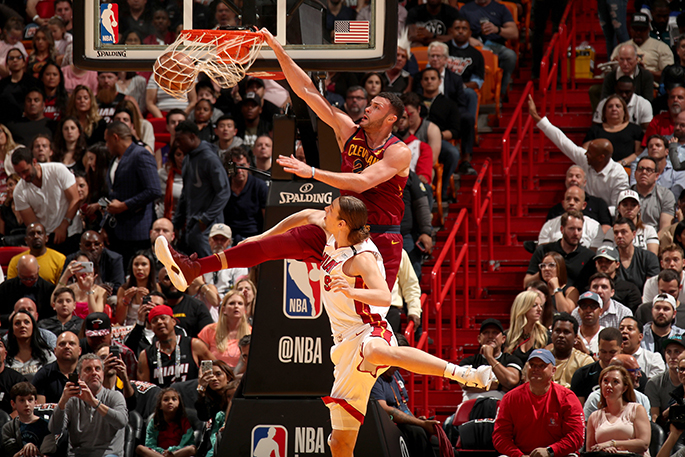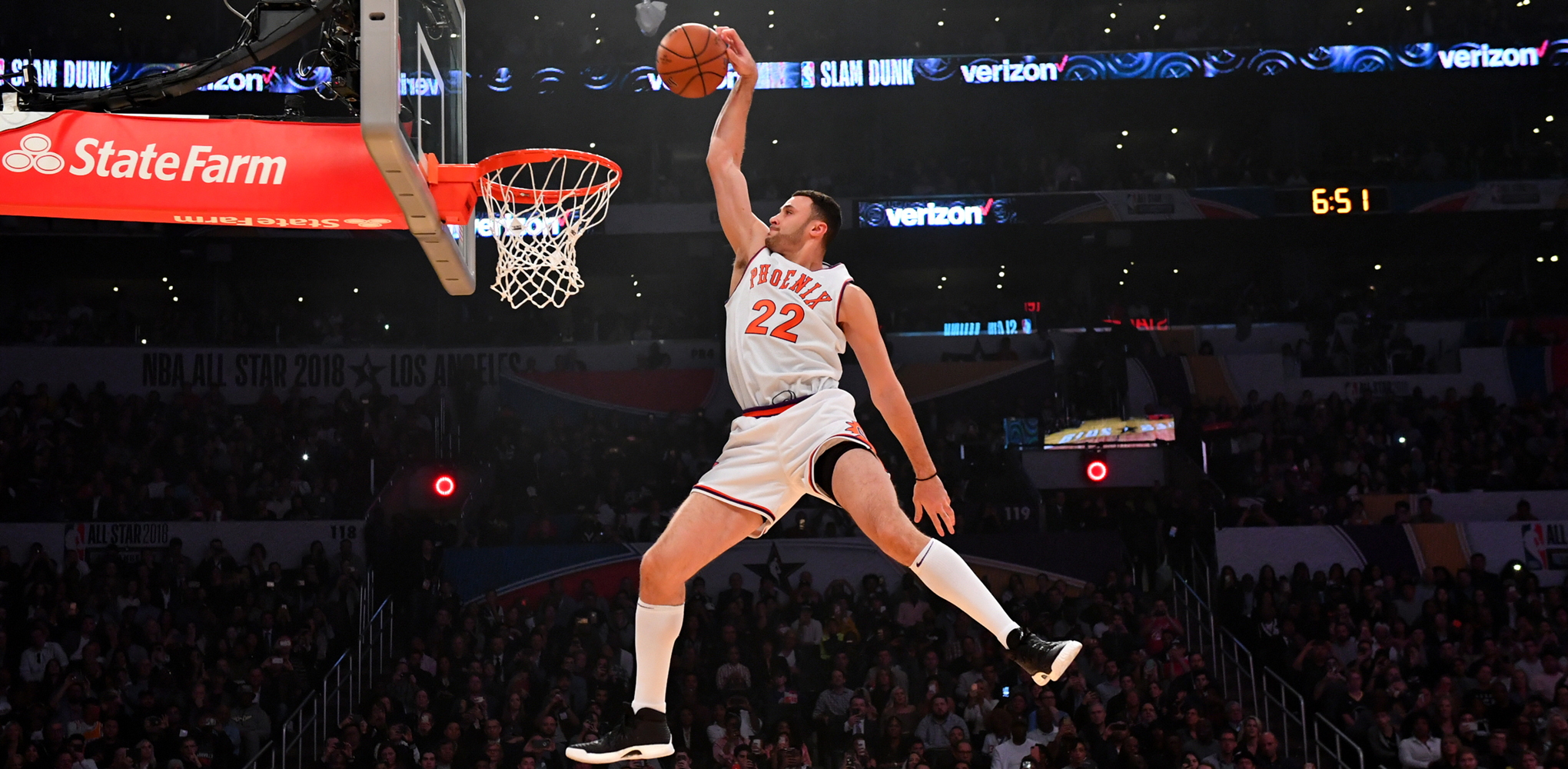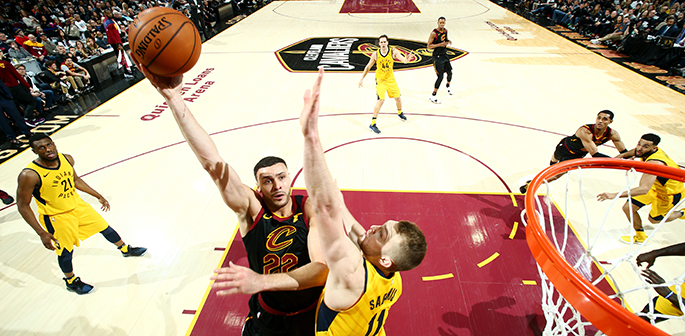It was a cool, damp, late-February morning in northeast Ohio, and the Cleveland Cavaliers’ suburban practice facility was nearly empty. Koby Altman, the Cavs’ first-year GM, was engaged in quiet conversation on a courtside bench. A gaggle of media clustered in one corner of the spacious gym, waiting for interviews. The side-by-side full courts that dominate the building were empty, save for three men: a pair of assistant coaches serving as screener and defender, and Larry Nance Jr., sweating through a workout. His teammates had long since hit the showers.
Two weeks earlier, Nance had arrived in Cleveland as one of the key pieces in a dramatic deadline-day trade that remade the Cavs’ roster—and, Altman and Cleveland fans desperately hoped, would salvage a season that increasingly appeared headed for an ugly and untimely demise. With Kyrie Irving gone, the Isaiah Thomas era over before it really started, and LeBron James weighing his options this summer, everyone agreed the Cavs had to do something. In February, they did; a pair of trades that involved five teams, 10 players, and a couple of future draft picks. If those deadline deals were the basketball equivalent of a defibrillator, it was Nance who had the potential to deliver the most potent jolt.

A 6-9, 230-pound forward/center, Larry Nance Jr. has made his name in three NBA seasons as an athletic big man whose upside is as impressive as his hops. But in one sense, of course, his name was already made before he ever got to the League: The son of a former All-Star forward who spent half of his 13-year career with the Cavs, the younger Nance was born in Akron and raised in suburban Cleveland, where he starred at Revere High School before going on to a terrific college career at Wyoming. In 2015, some 34 years after his father was a late-first-round pick of the Phoenix Suns, Nance was chosen 27th overall by the Los Angeles Lakers.
It was quite a time to be joining one of the League’s marquee franchises. Nance’s rookie year coincided with the final season of Kobe Bryant’s Hall of Fame career; it was also one of the worst seasons in team history, as the Lakers finished 17-65, dead last in the Western Conference. Given all that, Nance’s rookie numbers of 5.5 points and 5 boards in 20 minutes per game didn’t draw much attention either way.
With Kobe gone and first-year head coach Luke Walton in charge in 2016-17, Nance’s second NBA season felt a lot like a fresh start; he averaged 7 ppg and 6 rpg in 23 minutes per for a better-but-still-bad Lakers squad. Then came this season, and while his minutes stayed the same, he bumped his production up to just shy of 9 ppg and 7 rpg for a young, dynamic team that had the more patient purple-and-gold fans excited about the team’s future, and Nance’s place in it.
And then, in February, he was gone.
—
We caught up with Nance in April, in the home locker room before the Cavs’ playoff opener against the Indiana Pacers. More than two months since the trade that sent him from his first NBA home to his hometown team, Nance still gets asked plenty about his dad and his northeast Ohio roots. “It’s pretty cool that I’m with the team that I got to see my dad play so many games,” he says—specifying that by “watching,” he means on tape, since he was barely a year and a half old when his dad retired in 1994. “I’m just excited to be able to do the same thing in the same city.”
His dad remains a legend in Cleveland, remembered as a dynamic scorer and rebounder, one of the best shot blockers in NBA history, and of course, winner of the NBA’s first Slam Dunk Contest in 1984—nine years before his son was born. Larry Nance Sr. is still a regular at Cavs games, and his jersey hangs from the rafters of Quicken Loans Arena, a fact that made for interesting speculation when his son arrived. “He earned his right to have his number retired, and he deserves to keep it up there,” Nance said not long after the trade. “I didn’t even ask him about it.”
But Pops and Cavs owner Dan Gilbert apparently felt differently, and the League quickly approved an exception so Nance could wear his father’s No. 22 in Cleveland. It was appropriate timing, coming right after he wore his father’s throwback No. 22 Suns jersey in recreating his contest-winning cradle-windmill during All-Star weekend in L.A. He wasn’t able to match his dad’s victory that night, but the positive vibes were impossible to ignore. Now it was time to get serious.

In his first two seasons in L.A., Nance and the rebuilding Lakers never sniffed the playoffs. He wouldn’t have caught a whiff this year, either, but the midseason trade changed all that. Suddenly, he was part of a team that not only counted on a postseason berth, but expected to make a deep run. And expected him to play a key role.
As he sat in front of his locker scrolling his phone before Game 1, Nance didn’t seem bothered by the pressure of making his playoff debut. “I think I’m ready—I have to imagine it won’t catch me too off guard,” he said. “I’m pretty confident in my role and what I’m supposed to do on this team. My job is just to go out there tonight and play like any other game.” In that, he figures his role is pretty clearly defined. As Cavs coach Tyronn Lue said, “with Larry, I think it’s just making the right play—attacking the paint, rebounding, pushing it full-court, and then just rolling to the rim hard. Offensive rebounds, being active on the glass, putbacks, that’s what we need him for.”
Much was made of how the deadline trades made Cleveland “younger and more athletic,” qualities that the 25-year-old Nance personifies arguably more than anyone. But Altman, the Cleveland GM who has known the Nance family for years, says Nance’s value to the Cavs extends beyond the court. Acknowledging “the youth, the enthusiasm, the energy, the basketball IQ,” Altman says, “I think more than anything, I’ve known Larry for a long time, and his character, his work ethic—he’s an incredible human being. That’s what I knew I was bringing when I got him.”
Credit that to a positive upbringing, and also to the fortitude Nance had to develop in high school, when he was diagnosed with Crohn’s disease. The painful, chronic inflammatory disease almost cost Nance his basketball career, holding back his development and nearly causing him to quit the game. But he endured, developing into an all-state performer in high school, an All-Mountain West pick at Wyoming, and finally a first-round NBA draft pick.
His performance in his playoff debut echoed much of what he’s shown in his first three seasons. The Cavs were atrocious early against the Pacers, trailing 33-14 at the end of the first quarter en route to an 18-point Game 1 loss. But Nance was one of the few bright spots, if modestly so: Playing 29 minutes off the bench, he shot a typically efficient 5 of 7 en route to 10 points, pulled down 5 rebounds, and registered a pair of steals.

As Lue continues to try to make the best of an injury-riddled roster that looks nothing like the team Cleveland fielded three months ago, Nance has continued to see his minutes and production fluctuate. But he’s shown enough in his stint in Cleveland to make clear that the Cavs need him if they’re going to make yet another Finals run— let alone make it out of the first round.
However long they last in this year’s playoffs, the Cavs’ know that they—and LeBron James in particular—will once again be the focus of the NBA offseason. There’s no shortage of irony in the fact that Nance and teammate Jordan Clarkson were shipped from L.A. to Cleveland in a move meant simultaneously to help the Cavs keep LeBron happy in the short term, and help the Lakers clear cap space to be able to make a run at LeBron this summer. A strong playoff run, and the potential shown by new arrivals like Nance, figure to be among the factors LeBron will weigh in his decision. But as Altman made clear, uncertainty over LeBron’s 2018-19 destination is part of what made guys like Nance attractive: if LeBron does leave, Nance will be key to the young core that Cleveland will try to build around going forward.
For all the ways he’s followed his father’s footsteps, Larry Nance Jr. knows not even his dad ever had to fill shoes like that.
—
Ryan Jones is a Contributing Editor at SLAM. Follow him on Twitter at @thefarmerjones.
Photos via Getty Images.